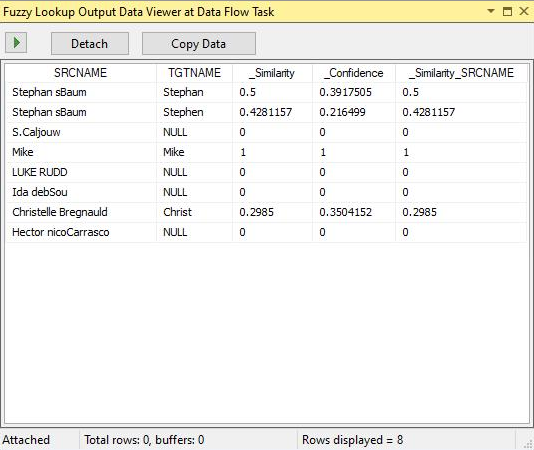Hi @Uma ,
As mentioned by Erland, we tried with SSIS's fuzzy matching component. We could have below output. It seems that it is not working with some situations like 'LUKE RUDD' and 'luky rodd'.

Later I found one good function 'Jaro-Winkler Stored Procedure' mentioned in
Roll Your Own Fuzzy Match / Grouping (Jaro Winkler) - T-SQL and it could be the perfect solution for your situation.
Firstly, you could create the function as mentioned in above link.
Then we could use this function and define the fuzzy matching degree should be more than 0.6 as below:
drop table if exists #src
DECLARE @SOURCE TABLE
(
SRCNAME VARCHAR(100)
)
INSERT @SOURCE
SELECT 'Stephan sBaum' UNION ALL
SELECT 'Ida debSou' UNION ALL
SELECT 'Hector nicoCarrasco' UNION ALL
SELECT 'LUKE RUDD' UNION ALL
SELECT 'S.Caljouw' UNION ALL
SELECT 'Christelle Bregnauld' UNION ALL
SELECT 'Mike'
DECLARE @TARGET TABLE
(
TGTNAME VARCHAR(100)
)
INSERT @TARGET
SELECT 'Stephen' UNION ALL
SELECT 'Hacktere' UNION ALL
SELECT 'Hacktery' UNION ALL
SELECT 'Stephan' UNION ALL
SELECT 'luky rodd' UNION ALL
SELECT 'Christ' union all
select 'Mike'
;with cte as (
select a.SRCNAME,b.TGTNAME,[dbo].[fn_calculateJaroWinkler](a.SRCNAME,b.TGTNAME) similar from @SOURCE a
cross apply @TARGET b)
select * into #src
from cte
where similar>0.6
and left(SRCNAME,1)=LEFT(TGTNAME,1)
select a.SRCNAME SCRCOLUMN,
sum(case when b.SRCNAME is null then 0 else 1 end) [No Of Occurance]
from @SOURCE a
left join #src b on a.SRCNAME=b.SRCNAME
group by a.SRCNAME
order by a.SRCNAME
select a.SRCNAME [SRC Name], b.TGTNAME [Targert Name]
from @SOURCE a
left join #src b on a.SRCNAME=b.SRCNAME
Output1:
SCRCOLUMN No Of Occurance
Christelle Bregnauld 1
Hector nicoCarrasco 2
Ida debSou 0
LUKE RUDD 1
Mike 1
S.Caljouw 0
Stephan sBaum 2
Output2:
SRC Name Targert Name
Stephan sBaum Stephen
Stephan sBaum Stephan
Ida debSou NULL
Hector nicoCarrasco Hacktere
Hector nicoCarrasco Hacktery
LUKE RUDD luky rodd
S.Caljouw NULL
Christelle Bregnauld Christ
Mike Mike
Best regards
Melissa
If the answer is helpful, please click "Accept Answer" and upvote it.
Note: Please follow the steps in our documentation to enable e-mail notifications if you want to receive the related email notification for this thread.



